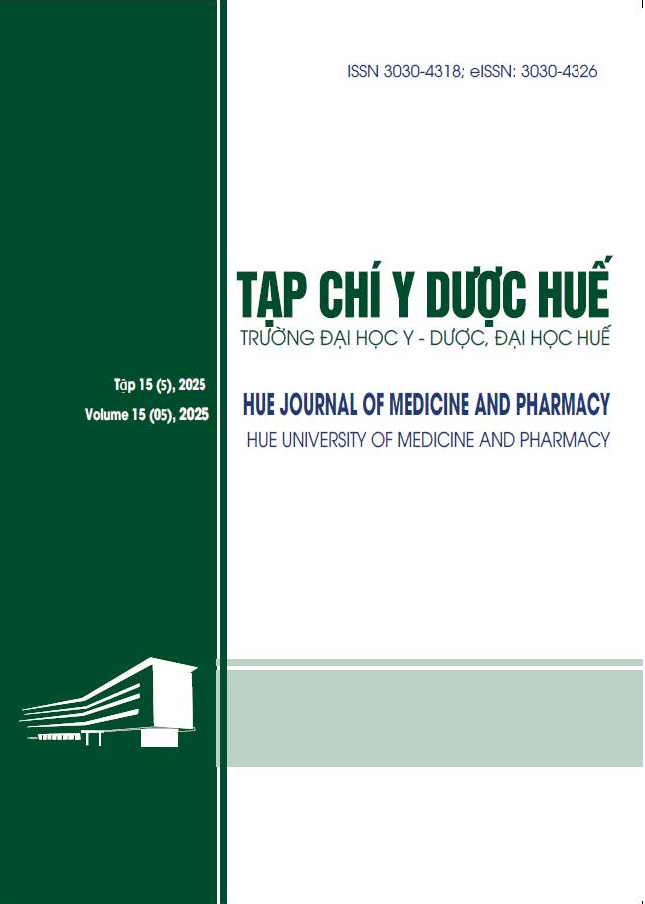Tóm tắt
Đặt vấn đề: Khô mắt là một bệnh đa yếu tố của bề mặt nhãn cầu, gây ra nhiều triệu chứng khó chịu cho bệnh nhân. Phẫu thuật phaco làm thay đổi hình thái phim nước mắt, có thể gây khô mắt hoặc làm trầm trọng thêm các triệu chứng khô mắt nếu không được điều trị kịp thời gây nên giảm chất lượng cuộc sống và thị lực của bệnh nhân.
Mục tiêu: (1) Khảo sát sự thay đổi các chỉ số liên quan đến khô mắt ở bệnh nhân sau phẫu thuật phaco. (2) Đánh giá một số yếu tố liên quan đến tình trạng khô mắt ở bệnh nhân sau phẫu thuật phaco.
Đối tượng và phương pháp nghiên cứu: Nghiên cứu mô tả tiến cứu được tiến hành trên 57 mắt của 46 bệnh nhân đục thể thuỷ tinh có chỉ định phẫu thuật phaco tại Bệnh viện Trường Đại học Y - Dược Huế.
Kết quả: Giá trị trung bình của chỉ số OSDI, test Schirmer, test FBUT lần lượt là 12,35 ± 4,01; 10,44 ± 6,51 mm, 6,98 ± 3,21 giây ở thời điểm 1 tuần sau phẫu thuật. Tỷ lệ khô mắt sau phẫu thuật 1 tuần chiếm 54,4%. Tỷ lệ khô mắt giảm dần và có sự hồi phục các chỉ số về khô mắt về gần như mức trước phẫu thuật ở thời điểm 1 tháng. Có sự khác biệt có ý nghĩa thống kê giữa tỷ lệ có khô mắt và thời gian tiếp xúc với ánh sáng.
Kết luận: Phẫu thuật phaco có thể gây ra tình trạng khô mắt, ảnh hưởng đến các giá trị các các test khô mắt sau phẫu thuật. Thời gian tiếp xúc với ánh sáng sinh hiển vi phẫu thuật là yếu tố nguy cơ dẫn đến khô mắt sau phẫu thuật phaco
| Đã xuất bản | 30-09-2025 | |
| Toàn văn |
|
|
| Ngôn ngữ |
|
|
| Số tạp chí | Tập 15 Số 5 (2025) | |
| Phân mục | Nghiên cứu | |
| DOI | 10.34071/jmp.2025.5.7 | |
| Từ khóa | Khô mắt, phẫu thuật phaco, thời gian vỡ màng phim nước mắt nhuộm fluorescein Dry eye, phacoemulsification, FBUT (Fluorescein tear break-up time) |

công trình này được cấp phép theo Creative Commons Attribution-phi thương mại-NoDerivatives 4.0 License International .
Bản quyền (c) 2025 Tạp chí Y Dược Huế
Pflugfelder SC, Stern ME. Biological functions of tear film. Exp Eye Res. 2020;197:108115.
Kasetsuwan N, Satitpitakul V, Changul T, Jariyakosol S. Incidence and pattern of dry eye after cataract surgery. PLoS One. 2013;8(11):e78657.
Garg P, Gupta A, Tandon N, Raj P. Dry eye disease after cataract surgery: study of its determinants and risk factors. Turk J Ophthalmol. 2020;50(3):133-142.
Huỳnh Phúc Hoàng, Huỳnh Phúc Nhĩ. Khảo sát sự thay đổi độ thẩm thấu nước mắt ở bệnh nhân sau phẫu thuật phaco.Tạp chí Y học Việt Nam. 2024;535(1B)e.
Ishrat S, Nema N, Chandravanshi S. Incidence and pattern of dry eye after cataract surgery. Saudi J Ophthalmol. 2019;33(1):34–40.
Sinha M, Sinha A, Chowdhury B. Comparative evaluation of dry eye following cataract surgery: a study from North India. IOSR J Dent Med Sci. 2014;13(6):13–18.
Lê Xuân Cung, Nguyễn Thị Thanh Nga, Nguyễn Xuân Hiệp, et al. Sự thay đổi của phim nước mắt sau phẫu thuật phaco. Tạp chí Y học thực hành. 2017;10(1059):27–30.
Chang P, Qian S, Xu Z, Huang F, Zhao Y, Li Z, et al. Meibomian gland morphology changes after cataract surgery: a contralateral eye study. Front Med (Lausanne). 2021;8:766393.
Chaithanya K, Nallamuthu P, Sripal A. Prevalence of dry eye in post-cataract surgery patients in a tertiary care hospital, Pondicherry. Int J Acad Med Pharm. 2023;5(3):839–842.
Trần Anh Tuấn, Huỳnh Phúc Hoàng. Khảo sát sự mất ổn định của phim nước mắt ở bệnh nhân sau phẫu thuật phaco. Tạp chí Y Dược học Phạm Ngọc Thạch. 2023;2(2):110–119.
Miura M, Inomata T, Nakamura M, Sung J, Nagino K, Midorikawa-Inomata A, et al. Prevalence and characteristics of dry eye disease after cataract surgery: a systematic review and meta-analysis. Ophthalmol Ther. 2022;11(4):1309–1332.
Cho YK, Kim MS. Dry eye after cataract surgery and associated intraoperative risk factors. Korean J Ophthalmol. 2009;23(2):65–73.






